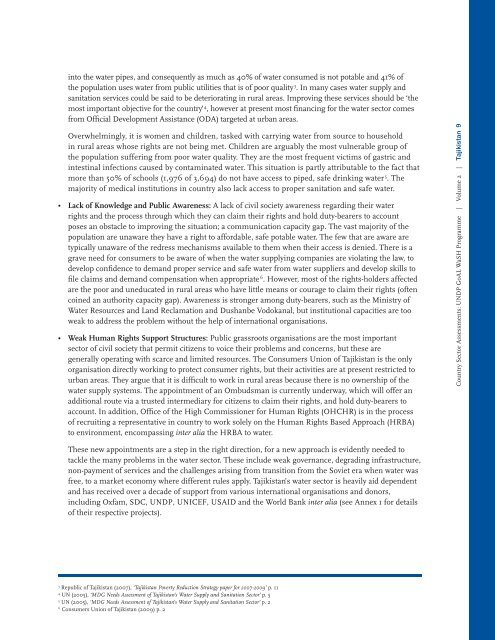Tajkistan - Water Governance Facility
Tajkistan - Water Governance Facility
Tajkistan - Water Governance Facility
You also want an ePaper? Increase the reach of your titles
YUMPU automatically turns print PDFs into web optimized ePapers that Google loves.
into the water pipes, and consequently as much as 40% of water consumed is not potable and 41% of<br />
the population uses water from public utilities that is of poor quality 3 . In many cases water supply and<br />
sanitation services could be said to be deteriorating in rural areas. Improving these services should be ‘the<br />
most important objective for the country’ 4 , however at present most financing for the water sector comes<br />
from Official Development Assistance (ODA) targeted at urban areas.<br />
Overwhelmingly, it is women and children, tasked with carrying water from source to household<br />
in rural areas whose rights are not being met. Children are arguably the most vulnerable group of<br />
the population suffering from poor water quality. They are the most frequent victims of gastric and<br />
intestinal infections caused by contaminated water. This situation is partly attributable to the fact that<br />
more than 50% of schools (1,976 of 3,694) do not have access to piped, safe drinking water 5 . The<br />
majority of medical institutions in country also lack access to proper sanitation and safe water.<br />
• Lack of Knowledge and Public Awareness: A lack of civil society awareness regarding their water<br />
rights and the process through which they can claim their rights and hold duty-bearers to account<br />
poses an obstacle to improving the situation; a communication capacity gap. The vast majority of the<br />
population are unaware they have a right to affordable, safe potable water. The few that are aware are<br />
typically unaware of the redress mechanisms available to them when their access is denied. There is a<br />
grave need for consumers to be aware of when the water supplying companies are violating the law, to<br />
develop confidence to demand proper service and safe water from water suppliers and develop skills to<br />
file claims and demand compensation when appropriate 6 . However, most of the rights-holders affected<br />
are the poor and uneducated in rural areas who have little means or courage to claim their rights (often<br />
coined an authority capacity gap). Awareness is stronger among duty-bearers, such as the Ministry of<br />
<strong>Water</strong> Resources and Land Reclamation and Dushanbe Vodokanal, but institutional capacities are too<br />
weak to address the problem without the help of international organisations.<br />
• Weak Human Rights Support Structures: Public grassroots organisations are the most important<br />
sector of civil society that permit citizens to voice their problems and concerns, but these are<br />
generally operating with scarce and limited resources. The Consumers Union of Tajikistan is the only<br />
organisation directly working to protect consumer rights, but their activities are at present restricted to<br />
urban areas. They argue that it is difficult to work in rural areas because there is no ownership of the<br />
water supply systems. The appointment of an Ombudsman is currently underway, which will offer an<br />
additional route via a trusted intermediary for citizens to claim their rights, and hold duty-bearers to<br />
account. In addition, Office of the High Commissioner for Human Rights (OHCHR) is in the process<br />
of recruiting a representative in country to work solely on the Human Rights Based Approach (HRBA)<br />
to environment, encompassing inter alia the HRBA to water.<br />
These new appointments are a step in the right direction, for a new approach is evidently needed to<br />
tackle the many problems in the water sector. These include weak governance, degrading infrastructure,<br />
non-payment of services and the challenges arising from transition from the Soviet era when water was<br />
free, to a market economy where different rules apply. Tajikistan’s water sector is heavily aid dependent<br />
and has received over a decade of support from various international organisations and donors,<br />
including Oxfam, SDC, UNDP, UNICEF, USAID and the World Bank inter alia (see Annex 1 for details<br />
of their respective projects).<br />
3 Republic of Tajikistan (2007), ‘Tajikistan Poverty Reduction Strategy paper for 2007-2009’ p. 11<br />
4 UN (2005), ‘MDG Needs Assessment of Tajikistan’s <strong>Water</strong> Supply and Sanitation Sector’ p. 5<br />
5 UN (2005), ‘MDG Needs Assessment of Tajikistan’s <strong>Water</strong> Supply and Sanitation Sector’ p. 2<br />
6 Consumers Union of Tajikistan (2009) p. 2<br />
Country Sector Assessments: UNDP GoAL WaSH Programme | Volume 2 | ����������� �


